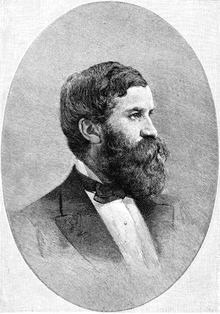Alpheus Spring Packard
| Alpheus Spring Packard, Jr. | |
|---|---|
 Packard circa 1888 | |
| Born |
February 19, 1839 Brunswick, Maine |
| Died | February 14, 1905 (aged 65) |
| Nationality | USA |
| Fields |
Entomology Palaeontology |
| Institutions | Brown University |
| Alma mater |
Bowdoin College, 1861 Harvard University, 1864 |
|
Signature | |
Alpheus Spring Packard, Jr., LL.D. (February 19, 1839 – February 14, 1905) was an American entomologist and palaeontologist. He described over 500 new animal species – especially butterflies and moths – and was one of the founders of The American Naturalist.[1]
Biography
He was the son of Alpheus Spring Packard, Sr. (1798–1884) and the brother of William Alfred Packard. He was born in Brunswick, Maine and was Professor of Zoology and Geology at Brown University in Providence, Rhode Island from 1878 until his death. He was a vocal proponent of the Neo-Lamarckian theory of evolution.[2]
His chief work was the classification and anatomy of arthropods, and contributions to economic entomology, zoogeography, and the phylogeny and metamorphoses of insects. Packard was appointed to the United States Entomological Commission in 1877 where he served with Charles Valentine Riley and Cyrus Thomas.[3] He wrote school textbooks, such as Zoölogy for High Schools and Colleges (eleventh edition, 1904). His Monograph of the Bombycine Moths of North America was published in three parts (1895, 1905, 1915, edited by T. D. A. Cockerell).
Writings by A. S. Packard Jr.
| Wikisource has original works written by or about: Alpheus Spring Packard |
- Report on the insects collected on the Penobscot and Alleguash Rivers, during August and September, 1861, Sixth Annual Report of the Secretary of the Maine Board of Agriculture, Augusta, Maine (pp. 373-376) (1861)
- Guide to the Study of Insects (1869; third edition, 1872)
- The Mammoth Cave and its Inhabitants (1872), with F. W. Putnam
- Life-History of Animals (1876)
- A Naturalist on the Labrador Coast (1891)
- Lamarck, the Founder of Evolution: His Life and Work (1901), French translation, 1903.
Notes
References
- Cockerell, T.D.A. (1920). "Biographical Memoir of Alpheus Spring Packard 1839-1905" (PDF). Biographical Memoirs of the National Academy of Sciences. 9: 181–236.
- Henshaw, Samuel (1887). The Entomological Writings of Dr. Alpheus Spring Packard. U.S. Department of Agriculture, Division of Entomology.
- Mallis, Arnold (1971). American Entomologists. Rutgers University Press. pp. 296–302. ISBN 0-8135-0686-7.
- Mead, A. D. "Alpheus Spring Packard (1839-1905)". Proceedings of the American Academy of Arts and Sciences. 53 (10): 848–850. JSTOR 25130026.
- Sorenson, W. Conner (1995). Brethren of the Net: American Entomologists, 1840-1880. University of Alabama Press.
External links
| Wikimedia Commons has media related to Alpheus Spring Packard. |
- Works by Alpheus Spring Packard at Project Gutenberg
- Works by or about Alpheus Spring Packard at Internet Archive
- Gallica Two works by Packard
- Brunoniana Biography
- Nomina circumscribentia insectorum On the phylogeny of the Lepidoptera. Zoologischer Anzeiger, 18 (465): 228-236 1895.